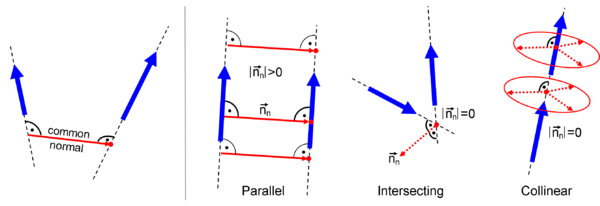Common normal
| ← Back: Types of joints | Overview: Denavit-Hartenberg Convention | Next: Assigning coordinate frames → |
The common normal is the shortest line perpendicular to the main joint axes of two consecutive joints. So it corresponds to the distance of two lines through the joints with the joint axes as direction vectors. This is illustrated on the left side of the figure on the right. The direction of the common normal can be computed using the cross product of the two main joint axes, so of the two  -axes:
-axes:
Its length depends on the spatial relation of the joint axes. There are some special cases, shown on the right side of the figure, that have to be considered when assigning the coordinate frames.
- Special cases
- When the two joint axes are parallel or antiparallel, the length of the common normal is distinct and larger than zero. But the position along the two axes is not distinct as two parallel lines have the same distance all over.
- When the lines through the two joint axes intersect, their distance and so the length of the common normal is
 . But the imaginary direction that the common normal would have is distinct and it would start (and end as it has length
. But the imaginary direction that the common normal would have is distinct and it would start (and end as it has length  ) in the intersection point.
) in the intersection point. - When the joint axes are collinear, their distance or the length of the common normal, respectively, is
 . The imaginary direction of the common is orthogonal to the joint axes. But as both lines are collinear it could be rotated by any angle about the line. Additionally its position along the line is not distinct.
. The imaginary direction of the common is orthogonal to the joint axes. But as both lines are collinear it could be rotated by any angle about the line. Additionally its position along the line is not distinct.
The left side of the figure below shows a 5-link manipulator in its zero position with already assigned main joint axes. The common normals now are determined based on each two consecutive main joint axes. The result is shown on the right side of the figure. The main axis of For The axes of Special case 1 appears between |


 is pointing upwards and the one of
is pointing upwards and the one of  to the right. As
to the right. As  -axis into the figure, the two lines are non-intersecting. This is the general case. So the shortest line perpendicular to both lines is pointing into the figure at the height of
-axis into the figure, the two lines are non-intersecting. This is the general case. So the shortest line perpendicular to both lines is pointing into the figure at the height of  we have the collinear case. So the length of the common normal is
we have the collinear case. So the length of the common normal is  intersect. So this is special case 2. The length of the common normal is
intersect. So this is special case 2. The length of the common normal is  because the two main joint axes are antiparallel. Thus the direction of the common normal is distinct and shown as a red line with a red dot at the end. Its location along the axes is not unique. In such cases, the origin of the distal joint is chosen for simplification. Further information about this follows in the article about the
because the two main joint axes are antiparallel. Thus the direction of the common normal is distinct and shown as a red line with a red dot at the end. Its location along the axes is not unique. In such cases, the origin of the distal joint is chosen for simplification. Further information about this follows in the article about the 